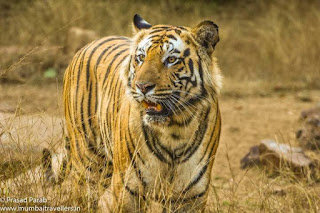Best places for Tiger and Wildlife Photography in India
Read about the best places for tiger and wildlife photography in India. Here is some more information about each of these national parks:
Bandhavgarh National Park:
Located in Madhya Pradesh, Bandhavgarh is known for its high density of tigers. It offers excellent opportunities for Tiger Photography Bandhavgarh, along with other wildlife such as leopards, sloth bears, and various bird species.
Kanha National Park:
Also situated in Madhya Pradesh, Kanha is one of India's largest national parks. It is renowned for its diverse flora and fauna, including tigers, leopards, Indian wild dogs, and several species of deer. The lush landscapes and picturesque meadows make it a great place for wildlife photography.
Ranthambore National Park:
Situated in Rajasthan, Ranthambore is famous for its population of Bengal tigers. The park's ancient ruins and scenic lakes add to the beauty of the wildlife sightings. Ranthambore is also home to other wildlife such as leopards, sloth bears, crocodiles, and various bird species.
Tadoba National Park:
Located in Maharashtra, Tadoba Andhari Tiger Reserve is known for its rich biodiversity. It offers opportunities to photograph tigers, leopards, Indian bison, and a wide range of bird species. The park's dense forests and picturesque landscapes make it a favorite among wildlife photographers.
Corbett National Park:
Situated in Uttarakhand, Jim Corbett National Park is India's oldest national park and a popular destination for wildlife enthusiasts. Apart from tigers, it is home to a variety of animals such as elephants, leopards, Himalayan black bears, and several species of deer. The park's location near the foothills of the Himalayas provides a stunning backdrop for wildlife photography.
These national parks provide well-organized safari tours and have experienced guides who can assist you in spotting and capturing wildlife in their natural habitats. However, it's important to remember to maintain a safe distance and follow the guidelines to ensure the well-being of both the animals and yourself.
The best time to visit these national parks for wildlife and tiger photography can vary based on the seasons and weather conditions. Here are the recommended months for both summer and winter visits:
Summer Wildlife and Tiger Photography Opportunity:
- Bandhavgarh National Park: April to June
- Kanha National Park: April to June
- Ranthambore National Park: April to June
- Tadoba National Park: March to June
- Corbett National Park: March to June
During the summer months, animals tend to come out more frequently near to the water sources due to the high temperatures, increasing the chances of wildlife sightings and tiger encounters. However, please note that summer months can be extremely hot in some regions, so be prepared for the heat, and carry necessary precautions like sunscreen, hats, and ample water.
Winter Wildlife and Tiger Photography Opportunity:
- Bandhavgarh National Park: November to February
- Kanha National Park: November to February
- Ranthambore National Park: November to February
- Tadoba National Park: November to February
- Corbett National Park: November to February
Winter months offer pleasant weather with cooler temperatures, making it an ideal time for wildlife photography. During this time, animals are often more active during the day, providing ample opportunities for capturing stunning photographs.
Real-Time Tiger Sightings: Stay Updated on Recent Encounters research
To conduct research on the best national parks in India for wildlife photography, you can utilize various sources and platforms. Here are some suggestions:
- Social media: Platforms like Instagram, Facebook, and Twitter can be valuable sources of information. Search for hashtags related to wildlife photography in India, such as #wildlifephotographyindia or #tigerphotography, to discover posts from photographers who have visited different national parks. Follow wildlife photography accounts or join relevant groups and communities to stay updated with the latest news and discussions.
- News: Stay informed about wildlife-related news and updates through online news portals, nature magazines, and publications dedicated to wildlife conservation. They often cover stories and articles on national parks, tiger sightings, and photography opportunities. Websites of prominent newspapers like The Times of India, Hindustan Times, or The Indian Express may have dedicated sections for wildlife or travel that can provide useful insights.
- Connect with photographers or wildlife lovers: Engage with photographers or wildlife enthusiasts who have visited national parks in India. You can do this through photography forums, online communities, or platforms like Flickr. Reach out to them directly to gather first hand experiences, tips, and recommendations on the best national parks for wildlife and tiger photography.
- WhatsApp groups: Joining WhatsApp groups dedicated to wildlife photography or Indian national parks can be an excellent way to connect with like-minded individuals. These groups often share updates, sightings, and valuable information about various national parks. Look for photography or nature-based groups on platforms like Facebook or photography forums, where members might share WhatsApp group invites.
To connect with local guides, drivers, and naturalists for your wildlife photography trip to national parks in India, you can follow these steps:
- Research local tour operators: Look for reputable tour operators that specialize in wildlife tours and photography expeditions in the specific national parks you plan to visit. Check their websites, read reviews, and assess their expertise in organizing wildlife photography trips. Local tour operators usually have a network of experienced guides, drivers, and naturalists.
- Join online forums and communities: Join online forums, travel communities, and photography groups where members discuss their experiences in Indian national parks. Seek recommendations from fellow photographers or travelers who have visited these parks before. They may share contact details of reliable guides, drivers, or naturalists they have personally engaged with.
- Reach out to local photography associations: Check if there are local photography associations or wildlife conservation organizations in the regions of the national parks you plan to visit. These associations often have members who are professional guides, drivers, or naturalists with extensive knowledge of the area. Contact them for recommendations or assistance in connecting with local experts.
When interacting with potential guides, drivers, or naturalists, ensure to discuss your specific photography requirements, preferred itinerary, and budget. Use their experience in wildlife photography and their familiarity with the national park. It's also essential to verify their credentials and licenses to ensure they are authorized to operate within the parks.








